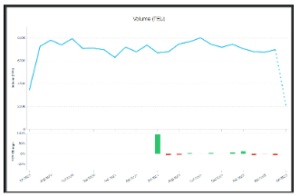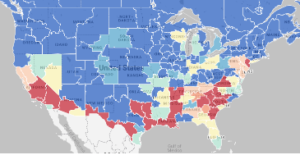Michael Paul, Sleek’s VP of Sales, has been helping shippers source qualified carriers for years now, and based on his expertise and what he’s witnessing overseas, he is predicting a high-water mark of containers will soon generate another capacity crunch at US Ports. To help support his point, Michael Paul said, “The Port of Savannah this past week moved 255K TEUs, and the same week in 2021 only moved 170K. Thankfully, port leadership had strong foresight and created a number of container yards which resulted in only 12-15 containers on water, versus 40-50.” Here are additional challenges, and what shippers can do now to proactively prepare to weather the approaching capacity crunch storm.
New Shanghai Quarantine Measures Will Have Resounding Impacts
This past April and May, as part of continued quarantine efforts, Shanghai closed several important highways which negatively impacted trucks carrying exports bound for city ports. To help mitigate delays, shippers began to rely on Ningbo and other smaller loading ports along the Yangtze River as alternate port destinations. As a result, the Port of Ningbo is now showing an increase in congestion.

Just as production and manufacturing levels were resuming in Shanghai, new restrictions were implemented which will negatively impact the supply chain and freight procurement. During the initial lockdown period, a trucking slowdown led to raw material shortages for large companies such as Volkswagen and Tesla. “Before the latest restrictions, truck drivers were still required to provide a nationally recognized 48-hour negative Covid test result and traffic permit”, said Akhil Nair, Asia-Pacific VP at Seko Logistics. He also noted that local governments continue to demand more testing. “Some drivers are cautious about delivering into Shanghai and capacity has yet to fully recover to pre-lockdown volumes.” Unfortunately, Michael said trucking capacity has not fully rebounded to pre-Covid levels, he believes we are still somewhere around 80%, which means the latest Shanghai quarantine restrictions come at a time when the supply chain is still trying to dig itself out of the Covid hole.
This past weekend, residents in fifteen of Shanghai’s sixteen districts were tested for the fast-spreading omicron variant. Five of those districts barred residents from leaving their homes, which will impact several worldwide manufacturing plants such as Tesla’s gigafactory, Merck, Covestro, L’Oreal, Thermo Fisher, SC Johnson, Siemens, Bosch, SAIC-GM, and Advanced Micro-Fabrication Equipment; and the specialty chemical manufacturing district of Xuhui. Apple, Sony, and Volkswagen have all said Shanghai’s “zero Covid” restrictions have impacted the supply of materials needed to make their products. Plus, the district of Jing’an is home to many semiconductor and electronics manufacturers.
Michael said that before the lockdowns started, congestion at China’s ports accounted for almost 15% of the global container backlog, versus roughly 33% now. Shanghai port authorities claim that the port is operating normally and has suffered zero delays due to a closed-loop system keeping staff on-site, despite numerous shipping analytics firms providing data to the contrary. Beyond the port of Shanghai, restrictions on cross-border trucking and movement throughout the city have prevented workers from off-loading and on-boarding shipping containers, creating delays.
U.S. Ports Already Feel The Pinch And Back to School & Holiday Aren’t Even Knocking On The Door Yet
West Coast ports are slowly processing containers, while East Coast and Gulf Coast ports are starting to feel the pinch. Orient Star Group noted a pickup in West Coast cargo, which had been trending down. This is a forward-looking indicator of the container uptick logistics experts have been predicting. Containers bound for the East Coast remain strong and stable.

Congestion in LA and Long Beach has impacted Oakland, which Michael suggested are skipped by ocean carriers trying to make up for lost time. Logistics managers are also trying to regain control by moving containers to the East Coast and Gulf Coast, resulting in these ports experiencing congestion, too. “Congestion measured in the number of waiting cargo vessels outside major ports is now worse on the East and Gulf coasts than on the West Coast, a major shift compared to the start of 2022,” said Mirko Woitzik, director of intelligence solutions at Everstream Analytics.

To keep up with growing container volume, the Port of Houston recently announced gate hours on Saturdays for the rest of the year. Warehouses at the Port of Savannah, Georgia (20M Sq ft being built currently), are 99% full and are using their pop-up container storage lots to free up land capacity. The average TEUs shipped from China to the US from January-March 2022 was 730,000 per month. Even with the diversion of containers from Shanghai to other ports, there is still going to bea backlog since the manufacturers were shut down. Shanghai provides an estimated 46% of China’s exports to the US (based on GDP). So, if 50% were diverted there could be an estimated backlog of 336K TEUs, which converts to 127,000 truckloads.
Current Major Ports Truck: Load Ratio- How high will they go?
Here’s a current snapshot of the truckload ratio by major ports:
- LA/LB 7:1
- Houston 7:1
- Savannah 8:1
- Charleston 8:1
- NJ 4:1
But it doesn’t stop there. Michael said Back to School and Holiday peak seasons have already started, which is supported by full warehouses across the country, as retailers pre-plan to ensure seasonal product volume coincides with increased customer demand. “So instead of huge volume peaks in July and September/October, there has been a constant flow of containers needing to pass through ports,” said Michael Paul. “Unfortunately, this indicates increased backlog, higher truckload ratios, increased truckload rates, and poor service levels.”

So What Can Shippers Do To Prepare?
Many shippers still rely on antiquated freight procurement processes, such as using a static waterfall process that leverages contracted carriers and freight brokers to ship goods. But what happens when times get tough? Michael said, “We all know the game. Contracted carriers reject loads, and brokers increase margins by 20-30%.” So ask yourself, do you have the right control levers in place to effectively manage harsh freight market swings? Will you have compliant trucks in the right place, at the right time, at a true market rate?
Resilient shippers successfully navigate the ebbs and flows of the freight market through automation technology. After unique shipper attributes are configured, shippers’ loads are dynamically matched to compliant carriers through an AI-powered, self-regulated freight marketplace that eliminates the need for freight brokers and RFPs. Just like Amazon, Shopify, and eBay have brought sellers and buyers together in a dynamic, real-time UX that serves as the pricing authority, freight procurement automation brings shippers and compliant small carriers together. With no broker middlemen, carriers control pricing (not a broker middleman) by bidding directly, and shippers gain an understanding of real-time market cost with 100% data transparency.
Source: CNBC Port Charts

